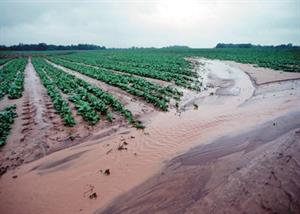Duane Hovorka, IWLA Agriculture Program Director
The science of soil health has made great strides in the last decade, but has public policy caught up with those advancements?
At the national level, decisions made in the next few months could tell us whether the next Farm Bill will reflect the new science of soil health and lead the way toward solutions to our water quality problems.
The League’s agenda for the five-year Farm Bill is centered on soil health and driving changes needed on farms and ranches to regenerate healthy soils. Healthy soils hold more water, reduce polluted runoff, store more carbon, grow healthier food, and are more resilient to drought and flooding.
 Soil scientists increasingly recognize that conventional farming practices – plowing and tilling the soil, heavy chemical use, leaving the ground barren for much of the year, cropping systems focused on just one or two crops like corn or soybeans, and confining livestock in gigantic feedlots and barns instead of grazing out on the land – are destroying the health of America’s soils. We now know that reversing these practices will re-build soil health and that – rigorously applied – farmers can see measurable improvements in just a few years.
Soil scientists increasingly recognize that conventional farming practices – plowing and tilling the soil, heavy chemical use, leaving the ground barren for much of the year, cropping systems focused on just one or two crops like corn or soybeans, and confining livestock in gigantic feedlots and barns instead of grazing out on the land – are destroying the health of America’s soils. We now know that reversing these practices will re-build soil health and that – rigorously applied – farmers can see measurable improvements in just a few years.
The Farm Bill can help move agriculture towards a future with healthier soil. The Senate and House have passed two very different versions of a new Farm Bill, and members of Congress and their staff are working out the differences.
Here are four areas where Congress could do much to ensure that the next Farm Bill is good news for soil health.
Soil Health Planning: The Farm Bill should ensure that U.S. Department of Agriculture (USDA) conservation programs help farmers develop and implement conservation plans that build soil health.
Incentives: Incentive payments through programs like the Conservation Stewardship Program and Environmental Quality Incentives Program should provide extra incentives for farmers who plant cover crops, adopt advanced grazing management, and put in place other practices that restore soil health. A soil health demonstration program would encourage farmers to adopt these practices and let USDA measure the results.
Good Farmer Discount: Farmers who adopt practices that rebuild soil health reduce the likelihood that they will have a crop loss in a drought that would trigger a crop insurance claim. The final Farm Bill should encourage USDA to offer a premium discount to farmers who adopt those practices, to reflect the lower risk they present to the crop insurance system. The bill should also ensure that farmers who use cover crops don’t get penalized by their crop insurance agent for doing so.
Research: The Farm Bill should add soil health to the list of high-priority USDA research topics. Congress should also establish a “data warehouse” to make information collected by USDA agencies available to researchers analyzing the links among conservation practices, soil health, profitability, and insurance risk. The bill should earmark a small share of conservation program funds to ensure USDA can assess and evaluate the effectiveness of its conservation programs. It should also provide for a USDA conservation practice database that includes effective soil health practices.
Taken together, these ideas could help improve the health of our nation’s soils. Ask your Members of Congress to support conservation programs that restore the health of America’s soils in the 2018 Farm Bill.
You can read more about these issues in the League’s agenda for the Farm Bill, “Healthy Soil, Healthy Water.” You can also sign up for our free e-news, Soil Matters, for updates on efforts at the federal and state levels to regenerate healthy soils.